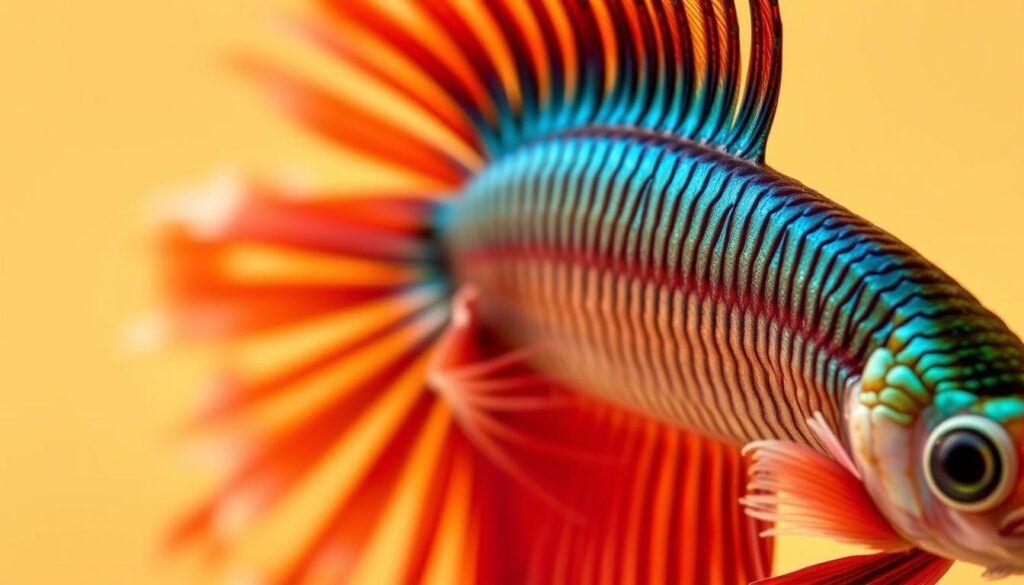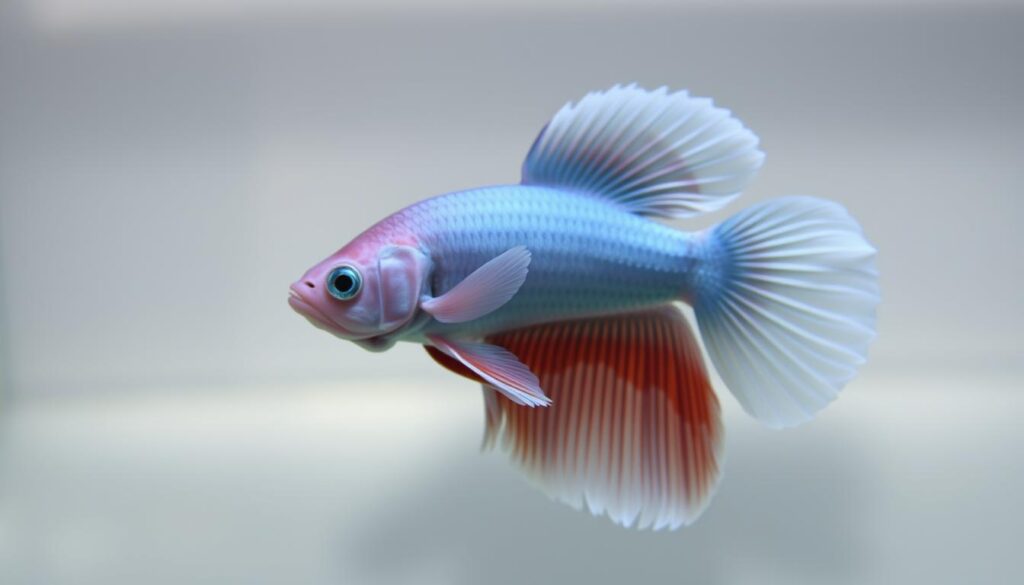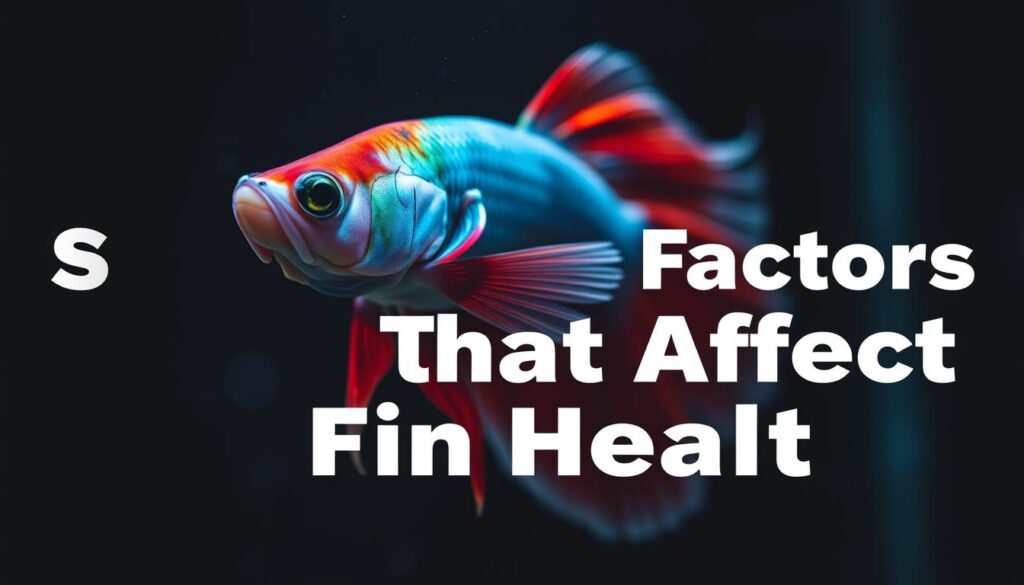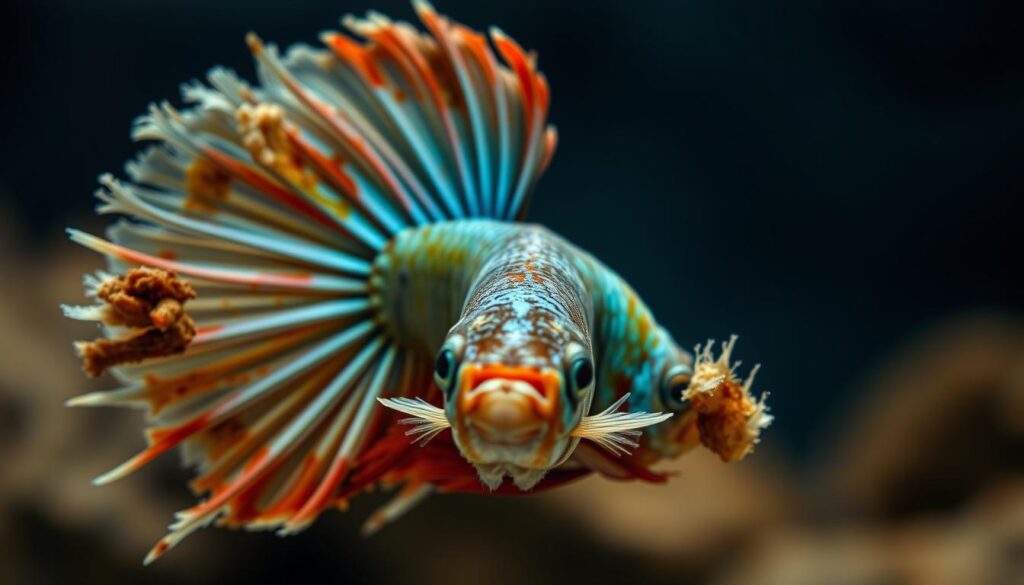Noticing your betta fish clamped fins lately? That’s a red flag every fish owner should pay attention to. Clamped fins in bettas often mean that something’s not right—whether it’s poor water quality, illness, or stress. It’s one of the most common early signs that your betta needs help, and fast.
We’re here to help you understand and address this issue. Your betta is trying to tell you something, and it’s our job to help you figure out what’s going on. Whether it’s stress symptoms or another issue, we’ll guide you through the causes, diagnosis, and treatment to get your vibrant pet back on track.
Key Takeaways
- Clamped fins are a sign of an underlying issue, not a disease.
- Stress symptoms can cause fins to clamp.
- Proper diagnosis is key to treating the issue.
- Adjusting the tank environment can help alleviate stress.
- Monitoring your betta’s behavior is crucial.
Understanding Clamped Fins in Betta Fish
Clamped fins in betta fish are more than just a cosmetic issue; they signal a deeper problem. As a betta owner, it’s crucial to understand what clamped fins are and why they’re a concern for your fish’s health.
What Are Clamped Fins?
Clamped fins refer to the condition where a betta fish holds its fins close to its body, rather than displaying them normally. This can be a sign of stress, poor water quality, or disease. When you notice your betta fish with clamped fins, it’s a signal that something is amiss in its environment.
Why Clamped Fins Are a Serious Concern
Clamped fins are not just a visual issue; they indicate that your betta is under stress or suffering from an underlying health problem. Ignoring this sign can lead to more severe health issues, affecting your betta’s overall well-being and longevity. Prompt action is necessary to address the root cause and prevent further complications.
Normal vs. Clamped Fin Appearance
A healthy betta fish typically displays its fins proudly, with the tail fin (caudal fin) being a vibrant, flowing appendage. In contrast, a betta with clamped fins will have its fins folded against its body, giving it a more streamlined but unhealthy appearance. Recognizing this difference is key to early detection and treatment.
| Fin Condition | Appearance | Indication |
|---|---|---|
| Normal | Fins displayed proudly, vibrant | Good health |
| Clamped | Fins held close to the body | Stress or illness |
Understanding and addressing clamped fins is crucial for maintaining your betta’s fin health and overall well-being. By recognizing the signs and taking prompt action, you can help your betta recover and thrive.
Recognizing Betta Fish Clamped Fins
As a betta fish owner, being able to recognize clamped fins is essential for providing the best care for your pet. Clamped fins can be a sign of stress, disease, or discomfort, and identifying the issue early can make a significant difference in your betta’s recovery.
Read Also Best Betta Fish Pellets: What to Feed & How to Choose the Right Ones
Visual Identification Guide
To identify clamped fins, you need to know what to look for. Here are some key signs:
Early Warning Signs
- Lethargy – If your betta fish is less active than usual, it could be a sign of clamped fins.
- Loss of appetite – A decrease in feeding interest can indicate health issues.
- Fins held tightly against the body – This is a clear visual sign of clamped fins.
Advanced Symptoms
- Labored swimming – If your betta is struggling to swim or is staying at the bottom of the tank, it’s a cause for concern.
- Visible infections – Fungal or bacterial infections can manifest as white spots, cotton-like growths, or redness.

Behavioral Changes to Watch For
Betta fish with clamped fins often exhibit behavioral changes. You might notice your betta hiding more than usual or showing a lack of response to stimuli. These changes can be subtle, so it’s essential to monitor your pet’s behavior closely.
According to betta care experts, “Monitoring your betta’s behavior and environment is crucial for early detection of health issues.” Let’s take a look at some common behavioral changes and their possible causes:
| Behavioral Change | Possible Cause |
|---|---|
| Hiding more than usual | Stress or fear |
| Lack of response to stimuli | Illness or discomfort |
| Loss of appetite | Disease or water quality issues |
By recognizing these signs and understanding their causes, you can take the necessary steps to help your betta fish recover from clamped fins.
Common Causes of Clamped Fins
Clamped fins are a common issue in betta fish, but what triggers this condition, and how can you help your fish recover? Understanding the root causes is crucial to providing the right treatment and care for your betta.
Water Quality Issues
Poor water quality is one of the primary causes of clamped fins in betta fish. Regular water testing can help identify issues with ammonia, nitrite, and pH levels.
Ammonia and Nitrite Toxicity
Ammonia and nitrite toxicity can cause significant stress to your betta fish, leading to clamped fins. Regular water changes and a proper filtration system can help mitigate these issues.
pH Imbalances
pH imbalances can also stress your betta fish, causing clamped fins. Maintaining a stable pH within the recommended range for betta fish is essential.
Temperature Problems
Temperature fluctuations can stress betta fish, leading to clamped fins. Keeping the water temperature stable between 76°F and 82°F (24°C and 28°C) is vital for your betta’s health.
Bacterial and Fungal Infections
Bacterial and fungal infections are another common cause of clamped fins. These infections can be treated with antibacterial and antifungal medications.
Parasitic Infections
Parasitic infections can also cause clamped fins in betta fish. Identifying the parasite and using the appropriate antiparasitic medication is crucial for treatment.
Here’s a summary of the common causes and their potential treatments:
| Cause | Symptoms | Treatment |
|---|---|---|
| Water Quality Issues | Clamped fins, lethargy | Regular water changes, proper filtration |
| Temperature Problems | Clamped fins, stress | Stable water temperature |
| Bacterial and Fungal Infections | Clamped fins, visible infections | Antibacterial and antifungal medications |
| Parasitic Infections | Clamped fins, visible parasites | Antiparasitic medications |

By understanding the common causes of clamped fins, you can take the necessary steps to treat and prevent this condition in your betta fish.
Stress Factors That Affect Fin Health
Stress is a silent killer for betta fish, often manifesting in clamped fins! When we talk about betta fish clamped fins, stress is often a significant underlying factor. Let’s dive into the common stressors that can affect your betta’s fin health.
Inadequate Tank Size and Environment
A tank that’s too small can be a significant stressor for your betta fish. Ideally, you should provide a tank that’s at least 5 gallons, with plenty of hiding places and plants to make your betta feel secure. A cramped environment can lead to stress, which in turn can cause clamped fins. So, give your betta some space to swim and thrive!
Aggressive Tank Mates
Aggressive tank mates can be a significant source of stress for your betta fish. If you’re housing your betta with other fish, make sure they’re compatible and not nipping at your betta’s fins. Fin nipping can lead to clamped fins, and the stress caused by aggressive tank mates can exacerbate the issue. Consider keeping your betta solo or with peaceful community fish.
Environmental Changes and Stressors
Sudden changes in water temperature, pH, or other environmental factors can stress your betta fish, leading to clamped fins. To minimize stress, make gradual changes to the tank environment, and avoid sudden swings in water parameters. By keeping the environment stable, you can help reduce stress and promote healthy fin growth.

By understanding and addressing these stress factors, you can help your betta fish recover from clamped fins and maintain overall health. Remember, a stress-free betta is a happy betta!
Diagnosing the Root Cause
Diagnosing the root cause of clamped fins in betta fish is a crucial step towards effective treatment and recovery. To do this, you need to understand the potential causes and how to identify them.
Complete Water Testing Protocol
A thorough water test is essential to diagnose the cause of clamped fins. This involves checking several key parameters to ensure your betta’s environment is healthy.
Essential Parameters to Check
- Ammonia levels
- Nitrite levels
- Nitrate levels
- pH levels
Interpreting Test Results
Once you have the test results, you need to interpret them correctly. For example, high levels of ammonia or nitrite can indicate poor water quality, which can cause clamped fins.
| Parameter | Ideal Range | Action if Abnormal |
|---|---|---|
| Ammonia | 0 ppm | Perform immediate water change |
| Nitrite | 0 ppm | Perform immediate water change |
| Nitrate | < 20 ppm | Perform partial water change |
| pH | 6.5-7.5 | Adjust pH gradually |
Differentiating from Other Fin Conditions
Clamped fins can be confused with other fin conditions such as fin rot or fin damage. Look for other symptoms like discoloration or fraying to differentiate.
When to Consult a Fish Veterinarian
If you’re unsure about the diagnosis or if your betta’s condition doesn’t improve with treatment, it’s time to consult a fish veterinarian for professional advice.

Immediate Actions for Betta Fish with Clamped Fins
If your betta fish is displaying clamped fins, don’t panic – we’ve got some urgent care tips to share with you! Clamped fins can be a sign of stress or illness, and taking immediate action is crucial to help your betta recover. So, what should you do first?
Emergency Water Change Procedure
Performing an emergency water change is often the first step in helping your betta fish with clamped fins. You should change about 25-50% of the tank water to improve water quality. Use a gravel vacuum to remove debris and waste products that can deteriorate water quality. Ensure the new water is dechlorinated and matches the tank’s temperature to avoid shocking your betta.
Optimizing Water Temperature
Betta fish prefer warmer waters, typically between 76°F to 82°F (24°C to 28°C). Check your tank’s temperature and adjust it if necessary. Sudden changes can stress your betta further, so make adjustments gradually. A stable, appropriate temperature can help reduce stress and promote healing.
Stress Reduction Techniques
Reducing stress is vital for your betta’s recovery. You can achieve this by providing plenty of hiding places and plants in the tank. These decorations give your betta a sense of security and help reduce anxiety. Additionally, ensure your tank isn’t overcrowded, as this can cause significant stress to your betta fish.
By taking these immediate actions – performing an emergency water change, optimizing water temperature, and reducing stress – you’re giving your betta fish the best chance to recover from clamped fins. Remember, if the condition persists, it’s always a good idea to consult with a fish expert or veterinarian for further guidance.
Treatment Options and Medications
Now that we’ve identified the potential causes of clamped fins in your Betta fish, it’s time to explore the various treatment options available! The treatment for clamped fins depends on the underlying cause, and understanding the right medication or approach is crucial for your Betta’s recovery.
Antibacterial Treatments
If your Betta fish is suffering from a bacterial infection causing clamped fins, antibacterial treatments are the way to go. These medications are specifically designed to target and eliminate bacterial infections.
Dosage Guidelines
Always follow the manufacturer’s instructions for the correct dosage. Typically, the dosage is calculated based on the volume of water in your tank.
Treatment Duration
The treatment duration can vary, but it’s usually recommended to continue the treatment for a few days after the symptoms have disappeared to ensure the infection is fully cleared.
Antifungal Solutions
Fungal infections are another common cause of clamped fins. Antifungal solutions can help treat these infections and promote healing.
When using antifungal medications, it’s essential to monitor your Betta fish closely for any signs of improvement or adverse reactions.
Antiparasitic Medications
If the clamped fins are due to a parasitic infestation, antiparasitic medications are necessary. These treatments are designed to eliminate parasites that may be causing the condition.
Natural Remedies and Salt Baths
For some Betta fish owners, natural remedies and salt baths can be an effective and less invasive treatment option. Salt baths, in particular, can help reduce stress and promote healing.
| Treatment Type | Cause | Example Medications |
|---|---|---|
| Antibacterial | Bacterial Infections | Kanacin, Metronidazole |
| Antifungal | Fungal Infections | API Fungus Cure, Methylene Blue |
| Antiparasitic | Parasitic Infestations | API General Cure, Seachem ParaGuard |
It’s crucial to diagnose the cause of clamped fins accurately to choose the correct treatment. Always monitor your Betta fish’s response to the treatment and adjust as necessary.
Setting Up a Hospital Tank for Recovery
Recovering from clamped fins requires a stress-free environment, and a well-set hospital tank can provide just that for your betta fish! When your betta is dealing with health issues, isolating it in a hospital tank can significantly boost its recovery chances.
Essential Equipment Needed
To set up an effective hospital tank, you’ll need a few key pieces of equipment. First, a heater is crucial for maintaining a stable temperature, which is vital for your betta’s health. You’ll also need a filter to keep the water clean, though make sure it’s not too strong for your betta. A thermometer is a must to monitor the water temperature accurately.
Optimal Water Parameters
Maintaining optimal water parameters is critical in a hospital tank. The ideal temperature should be between 78-82°F (25-28°C), and the pH should be around 6.5-7.5. Regular water changes will help keep these parameters stable.
| Parameter | Ideal Range |
|---|---|
| Temperature | 78-82°F |
| pH | 6.5-7.5 |
Monitoring and Maintenance Schedule
Regular monitoring is key to your betta’s recovery. Check the water parameters daily and perform partial water changes every other day. Clean the tank weekly to prevent the buildup of harmful bacteria.
By following these guidelines, you can create a safe and effective hospital tank that will help your betta fish recover from clamped fins and regain its health.
Recovery Timeline and Expectations
Let’s dive into the recovery process and explore what you can expect as your betta fish heals from clamped fins!
First 48 Hours of Treatment
The first 48 hours are critical in treating clamped fins in betta fish. You should start seeing some improvements if the root cause is being addressed. Monitor water parameters closely and make adjustments as necessary. Keep an eye on your betta’s behavior; if they’re still lethargic or showing signs of stress, it might be time to tweak the treatment plan.
During this period, maintain optimal water temperature and quality. Regular water changes are crucial, so don’t slack on those! If you’ve added any medications, continue to follow the instructions carefully to avoid over-medicating.
Week One Milestones
By the end of the first week, you should notice significant improvements in your betta’s fin condition and overall health. Fins might still be a bit clamped, but they should be on the mend. Look for signs of new fin growth and an increase in activity level. Your betta should be more active, exploring their surroundings, and maybe even showing some of that signature betta flair!
Long-Term Recovery Indicators
Long-term recovery is all about sustained health and the prevention of relapse. Ensure your betta’s tank is meticulously maintained, with regular water changes and a balanced diet. Monitor for any signs of stress or disease. A fully recovered betta will have vibrant colors, fully extended fins, and be active and engaged.
| Recovery Stage | Expected Improvements | Care Tips |
|---|---|---|
| First 48 Hours | Initial response to treatment, slight improvement in fin condition | Regular water changes, monitor water parameters |
| Week One | Noticeable fin improvement, increased activity | Continue optimal water conditions, adjust diet as needed |
| Long-Term | Fully recovered fins, vibrant colors, active behavior | Maintain tank hygiene, balanced diet, monitor health |
Recovering from clamped fins is a journey that requires patience, but with the right care and attention, your betta fish can make a full recovery. Stay vigilant, and you’ll be enjoying a healthy, thriving betta in no time!
Preventing Future Cases of Clamped Fins
Preventing clamped fins in betta fish is crucial for their overall health and well-being! You’ve taken the first steps by understanding the causes and treatments, and now it’s time to focus on keeping those fins flowing free.
Optimal Tank Maintenance Routine
Maintaining an optimal tank environment is key to preventing clamped fins. This means regular water changes – we recommend at least 25% every week – and ensuring your filtration system is working properly. Keep an eye on water parameters, and make adjustments as necessary to keep your betta fish thriving!
Nutrition and Diet Considerations
A balanced diet is vital for betta fish fin health. Feed your betta a variety of nutrient-rich foods, including high-quality commercial pellets and live or frozen treats like brine shrimp. Avoid overfeeding, as this can lead to digestive issues and stress, which can contribute to clamped fins.
Regular Health Monitoring Practices
Regularly monitoring your betta fish’s health is crucial for catching any potential issues early. Watch for signs of stress or disease, such as lethargy, loss of appetite, or visible damage to the fins. By staying vigilant, you can address problems before they become serious, keeping your betta fish happy and healthy. Keep an eye out for betta fish stress symptoms like hiding, rapid breathing, or clamped fins!
Conclusion: Ensuring Long-Term Fin Health for Your Betta
Maintaining your betta fish’s fin health is an ongoing process that involves understanding the causes of clamped fins, taking immediate action when they occur, and implementing long-term care strategies. By following these guidelines, you can help ensure your betta enjoys a long, healthy, and happy life!
To keep your betta’s fins in top condition, focus on proper tank maintenance, stress reduction, and regular health checks. This includes monitoring water quality, maintaining optimal water temperature, and providing a balanced diet. By being proactive, you can prevent issues like betta fish clamped fins and reduce the need for betta fish fin rot treatment.
So, what can you do to promote healthy fin growth? Regularly clean your tank, avoid overcrowding, and provide plenty of hiding places to reduce stress. By taking these steps, you’ll be well on your way to raising a thriving betta with beautiful, flowing fins!
Read Also Betta Fish Water Parameters: The Ultimate Guide to a Healthy Tank

